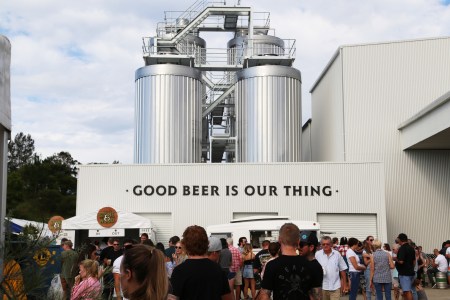
Stone & Wood is set to undertake a feasibility test for a new Thermal Energy Storage System (TESS).
Produced by 1414 Degrees, the system is expected to eliminate all of Stone & Wood’s gas usage. Instead, using electricity from the grid, the Murwillumbah brewery will heat silicon to a molten level (1414°C, hence the name of the company). The silicon will then be stored and its thermal energy will be used to power the brewery.
“Silicon is extremely efficient at holding its heat,” James Perrin, sustainability manager at Stone & Wood, explains to Beer & Brewer. “So it holds all of that heat which then later, we can use in a steam turbine or heat exchange. So we would draw steam from the system to heat our brewhouses, and we could use the electricity for refrigeration and other things. It’s essentially like a battery. It’s pretty cool technology.”
“For us, it’s another way to minimise and potentially even get off gas usage. At the moment, we generate steam by boiling by burning LPG and that generates steam. If we can create steam directly from this system then we’re completely off gas and then our only energy source then is electricity from the grid and if that’s the case we can potentially, look longer term at some renewable energy agreement which would allows us to go completely free of fossil fuels but 100% renewable.”
Another potential advantage is that the cost of electricity from the grid changes throughout the day, with prices far lower during the night than in daylight hours. This means that Stone & Wood could use cheaper night-time electricity to melt the silicon for use during the following day.
Perrin admits that electrical power from the grid still most likely involves burning fossil fuels, but his plan is to reduce the reliance on gas and then look at ways to renewably generate the electricity needed to melt the silicone. The brewery already has a 100kW system of solar panels at the Mumbah brewery, which has been in place for around five years, and Perrin hopes that electricity production for the grid will also become greener.
“As the grid is greening itself – more large scale solar farms, large scale wind farms into the grid and more PPA opportunities coming up for manufacturing sites to enter agreements with green energy – that’s becoming more viable so if we can reduce or even eliminate our direct gas usage and focus on greening our electricity usage that I think that’s the ultimate.”
A gas-fired version of the technology is being trialled at a waste water treatment plant in South Australia. In that system, the facility anaerobically digests the waste water, generating methane that can be burned to provide the heat for the units.
“There’s an opportunity for breweries who have an anaerobic digestor of their waste and waste streams to generate methane to fire up the system as well theoretically,” says Perrin. “It’s an emerging technology.
“We’re committed to a detail feasibility study to be done before the end of the year over the next few months we’ll be working with them on detail, engineering, design, feasibility, costings and things like that. By Christmas we should have a pretty good idea and whether this is economically and energy benefit. We want to do the due diligence.
“For these types of technology, you quite often need a guinea pig and we could potentially be one of the first to have the electricity unit installed all going well. And if things do go well, we want to open the books to allow people looking to install the same or similar technologies.”
